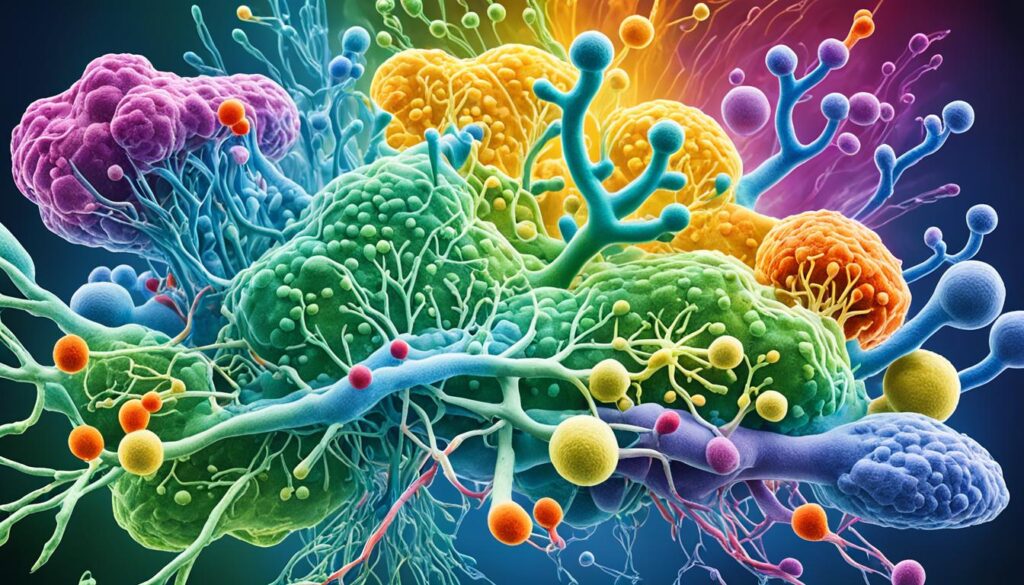What Happens When Camp Increases in the Cell
Cyclic adenosine monophosphate (cAMP) is key for how our cells work. It affects many of our body’s inside jobs. This key player helps cells talk to each other. We’ll look at how more cAMP changes things inside our cells.
Studying more about cAMP helps in a lot of ways. We learn how it affects our cells. This knowledge could even help find new ways to treat sickness. Understanding cAMP shows us how our bodies keep everything running smoothly.
Introduction to cAMP and Its Role in Cell Signaling
Cyclic adenosine monophosphate, or cAMP, is a key molecule in our cells. It was discovered in 1958 by Dr. Earl W. Sutherland. Cells make cAMP from ATP with the help of adenylyl cyclase. This enzyme is switched on by GPCRs at the cell surface. When cAMP is made, it triggers different actions in the cell. These actions affect things like how we use energy, control genes, and manage the flow of ions.
What is cAMP?
cAMP is a special type of molecule that helps cells communicate. It comes from ATP, and cells produce it with adenylyl cyclase. The job of adenylyl cyclase is often started by the arrival of chemical messengers at GPCRs. When cAMP is created, it sets off a chain reaction inside the cell. This reaction is like a series of switches turning on to do specific tasks.
The Importance of cAMP in Cellular Processes
cAMP is very important for many cell jobs. It helps with:
- Regulating the way we use and break down food, like breaking down glycogen when we don’t eat.
- Controlling which genes are turned on or off, especially during important cell activities.
- Affecting how ions move in and out of cells, which is key for normal function.
- Deciding when cells grow, divide, or change into different cell types, which is crucial for healing and growing new tissue.
All these jobs show why cAMP is critical in how our cells work. By learning about cAMP, we understand more about how our bodies function and stay healthy.
Mechanisms of cAMP Production and Regulation
At the core of cellular signaling is the way cyclic adenosine monophosphate (cAMP) works. It’s a key player that manages many body processes. The enzyme adenylyl cyclase changes ATP into cAMP. This change is vital in starting many pathways, often through G-protein coupled receptors (GPCRs).
Adenylyl cyclase reacts to different signals. It can speed up or slow down. This ability helps cells adjust cAMP amounts to outside and inside cues. For example, GPCRs can make adenylyl cyclase work more or less. This controls how much cAMP is around. This careful handling of cAMP is key for cells to work well and react properly to the world around them.
Along with making cAMP, its breakdown is also controlled. A group of enzymes called phosphodiesterases (PDEs) changes cAMP into its inactive form, AMP. This step is critical in controlling overall cAMP levels. Both adenylyl cyclase and phosphodiesterases work together, managed by different signaling steps. They make sure that cAMP does its job at the right time and place.
| Mechanism | Description | Key Players |
|---|---|---|
| cAMP Production | Conversion of ATP to cAMP catalyzed by adenylyl cyclase | Adenylyl cyclase, G-protein coupled receptors |
| cAMP Degradation | Conversion of cAMP to AMP catalyzed by phosphodiesterases | Phosphodiesterases |
| cAMP Regulation | Dynamic balance between production and degradation | Adenylyl cyclase, phosphodiesterases, signaling cascades |
Knowing how cAMP is handled helps scientists and doctors find new ways to treat using cAMP signals. This understanding is the key to decoding how cells talk to each other. It shows how versatile and important cAMP is in controlling bodily functions.

Pathways Activated by Increased cAMP Levels
When cAMP levels go up in a cell, it starts many signaling pathways. These include PKA and the control of ion channels and transporters.
cAMP-Dependent Protein Kinase Activation
Increased cAMP activates PKA, which is well-studied. PKA changes many target proteins, influencing metabolism, gene action, and differences in cells. PKA is key in turning cAMP signals into cell reactions.
When cAMP binds to PKA, it changes shape. This lets PKA’s parts that do work (catalytic) move freely. Then, PKA can change other proteins by adding phosphate groups. This can start or stop the proteins’ functions, changing how cells work.
Regulation of Ion Channels and Transporters
Elevated cAMP also affects how ion channels and transporters work. These help move ions like sodium and calcium into cells. Changing their activity with cAMP affects cell signals, excitement, and balance.
CAMP can adjust how ion channels open and close. This changes ion flow and can impact nerve signals, muscle motion, and hormone release.
By using PKA and controlling ion activity, cAMP directs many cell reactions. It’s crucial for the cell’s functions.
Physiological Effects of Elevated cAMP Levels
The level of cAMP in a cell can change many things in our bodies. It can speed up how we burn sugar and fat. It also affects how energy is made and stored.
Effects on Metabolism
High cAMP levels start a chain reaction that breaks down glycogen. Glycogen is stored sugar in our body. This quick process gives cells energy when needed. Also, it boosts the breakdown of fats into fatty acids. These acids are then used as fuel.
Effects on Gene Expression
CAMP doesn’t stop there. It also influences how our genes act. It does this by turning on certain genes that help cells grow, change, and adapt. This process allows cells to react to their surroundings. It’s key in keeping the body working well and might affect health and disease.
FAQ
What is cAMP and its role in cell signaling?
cAMP stands for cyclic adenosine monophosphate. It’s a key player in cell processes. Cells make cAMP from ATP with adenylyl cyclase, which GPCR often turns on. cAMP then wakes up PKA, inspiring various cell works like metabolism, genetic tasks, and adjusting ion flows.
How is the production and regulation of cAMP controlled?
Adenylyl cyclase carefully manages cAMP production from ATP. It responds to different signals, often through GPCRs. What goes up must come down, so PDEs keep cAMP levels in check by turning it into AMP.
What are the pathways activated by increased cAMP levels?
Boosted cAMP rallies PKA to action. This enzyme tweaks many cell tasks, from metabolism to gene actions and cell specialization. Also, upped cAMP can tweak ion movers, which changes cell membrane ions and operations.
What are the physiological effects of elevated cAMP levels?
High cAMP shake-ups offer big health wins. It fuels extra glycogen busting and fat release. Plus, it guides gene tweaks for growth, change, and fit reactions.
How is the dysregulation of cAMP signaling associated with certain diseases?
Skewed cAMP guidance can lead to metabolic ills, nerve issues, and some cancers. Figuring out these links could help make tailor-made fixes and maybe new cures by steering cAMP better.
